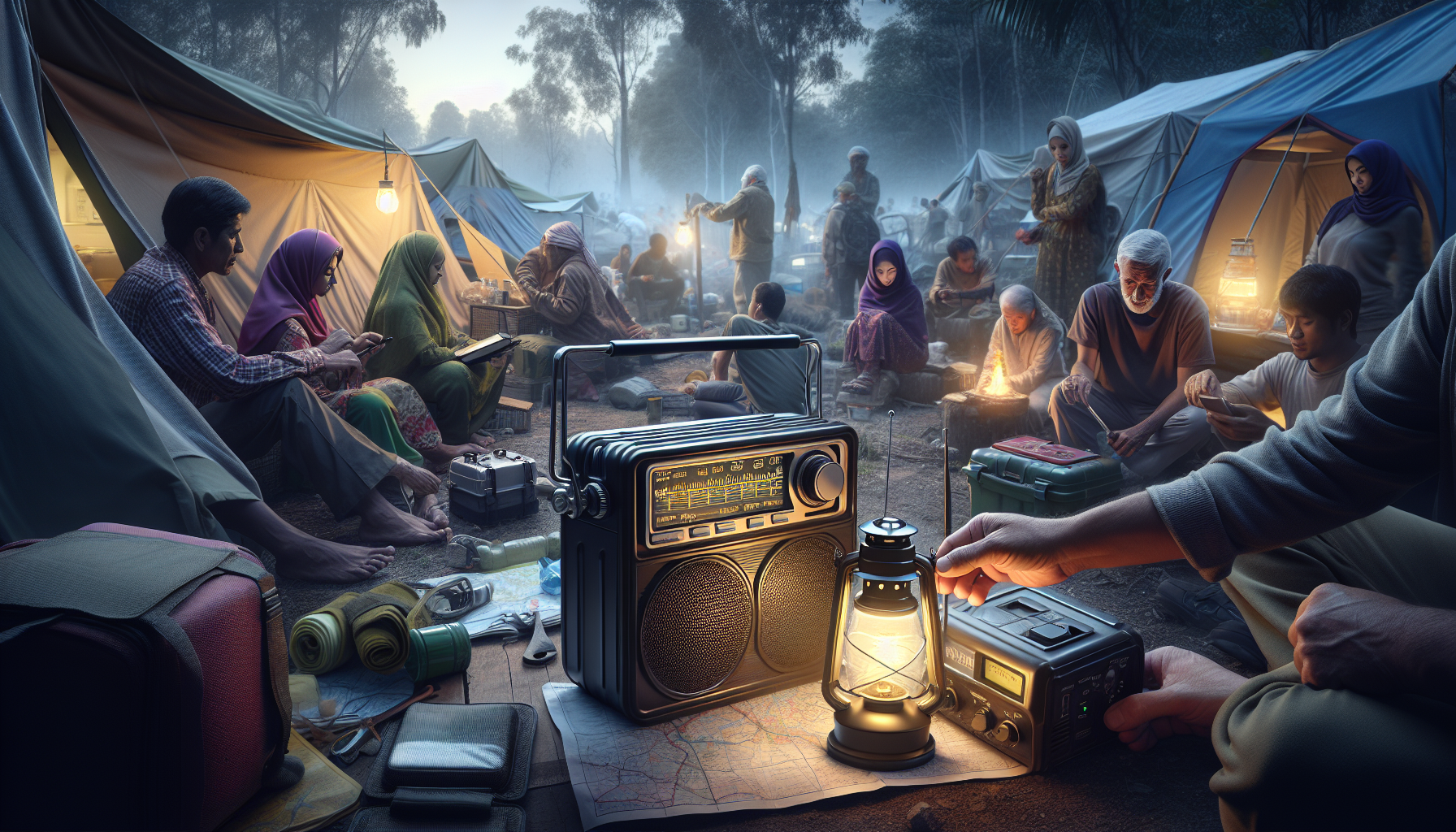In a world where unpredictability seems to be the only constant, staying prepared for emergencies is not just a prudent choice—it’s essential. Natural disasters, unexpected power outages, and unforeseen crises can strike without warning, leaving us in the dark and disconnected from the world. In these moments, the ability to stay informed and maintain power becomes crucial, turning potentially dire situations into manageable challenges. This is where crank radios and generators come into play, serving as vital tools in our emergency preparedness arsenal. ⚡📻
Imagine a sudden storm rolling in, cutting off electricity and silencing the usual hum of modern life. Without power, we’re left vulnerable, our connection to the outside world severed. Yet, with a reliable crank radio, you can tune into emergency broadcasts, receive critical updates, and stay connected to vital information—all without the need for conventional power sources. These radios, powered by hand-cranked generators, solar panels, or even batteries, are designed to function in the toughest conditions, ensuring that you never miss a crucial alert. They are the unsung heroes of disaster preparedness, keeping you informed when it matters most.
Similarly, generators stand as powerful allies in the face of adversity, offering a lifeline when the grid goes down. Whether it’s a compact portable generator perfect for camping trips or a robust home standby unit, these machines provide the energy needed to keep essential appliances running, charge devices, and maintain a semblance of normalcy amidst chaos. From keeping your refrigerator operational to powering medical equipment, generators offer peace of mind and security, making them indispensable during emergencies. By exploring the different types, features, and maintenance tips, you’ll be equipped to choose the right generator to meet your specific needs.
In this comprehensive guide, we will delve into the world of crank radios and generators, exploring their functionalities, benefits, and how they can be integrated into your emergency preparedness plan. We’ll discuss the key features to look for, offer tips on maintaining these devices for longevity, and even share real-life stories of how they’ve made a difference in critical situations. Whether you’re a seasoned prepper or just beginning to consider the importance of emergency readiness, this guide will equip you with the knowledge and confidence to stay powered up, no matter what challenges come your way. Join us as we uncover the power of preparedness and ensure that when the unexpected strikes, you’re not left in the dark. 🌟
Understanding the Importance of Emergency Preparedness
Emergency preparedness is more than just a buzzword; it’s a crucial aspect of ensuring safety and sustainability during unforeseen circumstances. From natural disasters like hurricanes, earthquakes, and floods to man-made crises such as power outages and accidents, being prepared can make the difference between life and death. While we often rely on modern technology for our daily activities, these can become vulnerable during emergencies. Therefore, having a backup plan is essential.
In this context, crank radios and generators play an essential role. These devices provide the necessary power and communication channels that can be vital in keeping you informed and connected. Crank radios, which are powered manually, are particularly useful because they do not rely on batteries or electricity, making them indispensable during power outages. On the other hand, generators offer a more robust power solution, ensuring that essential appliances can continue running even when the grid is down.
By understanding how these devices work and their applications, you can significantly enhance your emergency preparedness plan. This guide explores the different types of crank radios and generators, their features, and how they can be effectively integrated into your preparedness strategy. As you read on, you’ll gain valuable insights that will empower you to stay powered up during emergencies.
Crank Radios: Your Lifeline During Emergencies
Crank radios are a quintessential tool for anyone serious about emergency preparedness. Unlike regular radios that depend on batteries or electricity, crank radios are designed to be self-sufficient. They typically feature a hand-crank generator, solar panels, and sometimes even USB ports for additional charging options. This versatility ensures that you can stay informed about weather conditions, emergency broadcasts, and news updates, regardless of the situation.
One of the main advantages of crank radios is their simplicity. Operating them requires no technical expertise, making them accessible to people of all ages. Many models come with additional features such as built-in flashlights, SOS alarms, and even phone charging capabilities, adding to their utility. When choosing a crank radio, consider factors such as battery life, charging options, and additional features that might be beneficial in an emergency.
To understand how these radios function, imagine a scenario where a severe storm has knocked out power lines, leaving entire neighborhoods in the dark. In such situations, a crank radio becomes a lifeline. By simply cranking the handle, you generate enough power to tune into emergency frequencies and receive vital updates. Below, you’ll find a comparative table of popular crank radios to help you choose the best option for your needs.
| Model | Power Sources | Additional Features | Price Range |
|---|---|---|---|
| Radio Model A | Hand Crank, Solar, USB | Flashlight, SOS Alarm, Phone Charger | $30 – $50 |
| Radio Model B | Hand Crank, Battery | AM/FM/NOAA Weather, Flashlight | $20 – $40 |
| Radio Model C | Hand Crank, Solar, Battery | Bluetooth, Phone Charger | $40 – $60 |
Check out this video to see a detailed review of some of the top crank radios on the market. It offers a hands-on demonstration of their features and capabilities. 🎥
Generators: Powering Through the Darkness
While crank radios are excellent for communication and small power needs, generators are the heavyweights of emergency preparedness. They provide the power necessary to run larger appliances like refrigerators, lights, and even medical equipment, ensuring that your home remains functional during extended power outages. Understanding the different types of generators and their specific use cases is vital for making an informed decision.
Generators come in various types, including portable, inverter, and standby generators. Portable generators are ideal for short-term outages and can be easily moved to where they are needed. Inverter generators are known for their fuel efficiency and quieter operation, making them suitable for sensitive electronics. Standby generators, although more expensive, offer an automatic power backup solution, kicking in as soon as the grid goes down.
When selecting a generator, consider factors like power output, fuel type, and noise level. For instance, if you live in an area prone to severe weather, a generator with a higher wattage output would be advisable to ensure you can power all necessary appliances. The table below provides a comparison of different types of generators and their features.
| Type | Power Output | Fuel Type | Best For |
|---|---|---|---|
| Portable Generator | 2,000 – 10,000 watts | Gasoline, Diesel | Short-term outages |
| Inverter Generator | 1,000 – 4,000 watts | Gasoline | Camping, Electronics |
| Standby Generator | 10,000 – 20,000 watts | Natural Gas, Propane | Whole-house backup |
For a comprehensive understanding of how generators work and tips on maintenance, watch this insightful YouTube video from a trusted channel. 📺
Fuel Types and Their Impact
The choice of fuel is another critical factor when considering a generator. Each fuel type has its advantages and disadvantages, influencing factors such as cost, availability, and environmental impact. Gasoline, for example, is widely available but has a shorter shelf life compared to other fuels. Propane, on the other hand, is cleaner and can be stored for longer periods, making it a preferred choice for standby generators.
Understanding these differences can help you make a more sustainable and cost-effective choice. Additionally, fuel efficiency varies between models, so it’s important to evaluate the fuel consumption rates of different generators. As part of your emergency preparedness plan, ensure that you have an adequate supply of fuel and a safe storage solution.
Integrating Crank Radios and Generators into Your Emergency Plan
Now that you have a grasp of how crank radios and generators function, it’s time to integrate them into your emergency preparedness plan. Start by assessing your specific needs. Do you live in an area with frequent power outages? Are there family members with medical needs that require consistent power? These questions will help you determine the right combination of devices.
Once you’ve identified your needs, create an inventory of the necessary equipment and ensure that each device is in working order. Conduct regular checks and maintenance to ensure functionality during emergencies. For crank radios, this means testing the hand crank and battery levels, while generators require fuel checks and engine tests.
Finally, educate your household members on how to use these devices. Conduct drills to ensure everyone knows how to operate the crank radio and generator during an emergency. By doing so, you can minimize panic and ensure a more coordinated response. Below is a checklist to help you integrate these tools effectively:
- Assess your power needs and identify critical devices.
- Choose the right type of crank radio and generator for your situation.
- Create an inventory and conduct regular maintenance checks.
- Store an adequate supply of fuel safely.
- Educate family members and conduct emergency drills.
With these steps, you’ll be well on your way to creating a comprehensive emergency preparedness plan that keeps you and your loved ones safe and informed.

Conclusion
In conclusion, staying prepared for emergencies is not just a recommendation but a necessity in today’s unpredictable world. Our exploration of crank radios and generators highlights the crucial role these tools play in ensuring safety, communication, and power during crises. Throughout this article, we’ve delved into various aspects of emergency preparedness, focusing on how crank radios and generators can be invaluable assets.
To recap, we began by examining the fundamentals of emergency preparedness, emphasizing the unpredictability of natural disasters, power outages, and other unforeseen events. The importance of having a reliable source of information and power during such times cannot be overstated. Crank radios, with their ability to receive vital weather updates and news broadcasts without relying on an external power source, emerge as a cornerstone in emergency kits. They offer not just peace of mind but also the potential to make life-saving decisions in critical moments.
We then moved on to explore the various types of crank radios available in the market, highlighting key features that consumers should consider when making a purchase. From battery life and charging options to additional features like built-in flashlights and solar panels, we provided a comprehensive guide to help readers select the most suitable crank radio for their needs.
Similarly, generators were discussed as essential tools for maintaining power when the grid fails. We outlined different types of generators, including portable and standby models, and offered guidance on factors like power output, fuel type, and noise levels. Understanding these nuances can help individuals choose a generator that aligns with their specific requirements and circumstances.
Moreover, we touched upon the environmental impact of using generators and the advancements in eco-friendly options. With growing concerns about climate change, opting for greener alternatives such as solar-powered generators can significantly reduce one’s carbon footprint while still ensuring preparedness.
The synergy between crank radios and generators forms the backbone of a robust emergency preparedness plan. Together, they provide the dual benefits of staying informed and powered, regardless of external conditions. The importance of these tools extends beyond just individual preparedness. They foster a culture of resilience and readiness within communities, empowering people to support one another in times of need.
As we close this discussion, it is vital to emphasize that emergency preparedness is an ongoing process. It involves regularly updating and testing your equipment, staying informed about potential risks in your area, and continuously educating yourself and your loved ones about best practices.
We encourage you to reflect on the insights shared in this article and consider how they can be applied to enhance your own preparedness strategies. Share this knowledge with friends and family, fostering a community of well-informed and equipped individuals ready to face any challenges that may come their way.
Your engagement is invaluable. We invite you to share your thoughts and experiences in the comments section. Have you used a crank radio or generator during an emergency? What lessons have you learned? Your insights could be the inspiration someone else needs to take that crucial step toward readiness.
In a world where the only certainty is uncertainty, let us all strive to stay powered up, informed, and prepared. Together, we can build a safer, more resilient future. 🌍🔋
National Weather Service on Emergency Preparedness
American Red Cross Emergency Preparedness Guide
Toni Santos is a visual researcher and design historian whose work excavates the hidden aesthetics of Cold War underground architecture. Through a precise and atmospheric lens, Toni explores the secretive world of bunkers, fallout shelters, and subterranean control rooms—spaces where fear met function and design became a quiet weapon of survival.
His journey is anchored in a fascination with how psychology, geopolitics, and architecture collided beneath the surface. From brutalist safe havens carved into mountains to color-coded civil defense manuals, Toni’s narratives reveal how underground design reflected not just strategic utility, but an entire culture of suspicion, endurance, and visual control.
With a background in archival visual storytelling and spatial design theory, Toni reconstructs the emotional and symbolic language of Cold War interiors—highlighting sterile aesthetics, retro-futuristic technology, and the unspoken codes of protection embedded in every detail.
As the curator of Vizovex, Toni shares rare blueprints, visual analyses, and interpretive essays that bring forgotten Cold War spaces back into the cultural imagination—offering a deeper understanding of the architecture of anxiety and hope.
His work is a tribute to:
The visual psychology of Cold War safety design
The overlooked beauty in utilitarian environments
The role of design in shaping perception during times of fear
Whether you’re a student of history, a lover of mid-century design, or someone drawn to the unseen layers of the past, Toni invites you underground—where silence was strategy, and every bolt, map, and fluorescent bulb held meaning.





